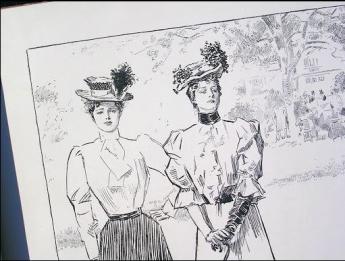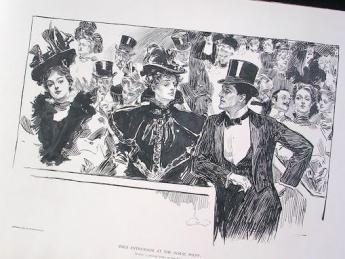Antiquarian Booksellers' Association of America Lighthouse Books, ABAA
Collecting - America's Gibson Girl: the Good Years

By Michael Slicker
The period from 1900 to the First World War (what historian Walter Lord called “the good years” in America) was a rare time after plumbing and before the federal income tax was reintroduced, when Americans lived with confidence.
Perhaps the epitome of that era was the Gibson Girl, an ideal of American feminism created by illustrator Charles Dana Gibson. She was beautiful, intelligent, sturdy and unruffled. She was created before the turn of the century and held sway for more than two decades.
In 1886, Gibson sold his first illustration to Life magazine for $4, a drawing of a dog chained to his doghouse, howling at the moon. It was a far cry from the illustrations that were to bring him fame and fortune, but it was a start, and over time Gibson built a following for his work. He earned enough money for a trip to France and England to study art. In England, he met George du Mauier, whose satiric drawings for Puck and drawings of fashionable women were the rage in London. Du Mauier’s work inspired Gibson.
Soon Gibson was drawing aristocratic American women with a hint of spunk. Gibson’s work appeared in Harper’s, Collier’s and Life. Gibson’s woman captured the national imagination. She was tall and slender with a long, thin neck and upswept hair with cascading curls. She had an impossible hourglass figure that has led some social critics to compare her with Barbie of a more recent era. Probably what attracted readers most, though, was that mischievous look in her eye. She was a bit of a tease and an equal companion to men. She reflected the confidence of the era.
Gibson’s wife posed for his illustrations, as did seductive chorus girl Evelyn Nesbit, who would later gain fame for her involvement in the murder of her ex-lover, the well-known architect Stanford White. Actress Camille Clifford was also among the more famous Gibson girl models. Many other women Gibson and, in later years, several would claim to be the original “Gibson Girl.”
For his part, Gibson claimed that she represented the beauty of American women.
"I'll tell you how I got what you have called the 'Gibson Girl.' I saw her on the streets, I saw her at the theatres, I saw her in the churches. I saw her everywhere and doing everything. I saw her idling on Fifth Avenue and at work behind the counters of the stores …”
Before the turn of the century, the Gibson Girl came to dominate popular American culture. She appeared on products from pillowcases to tablecloths and umbrella stands to ashtrays. Like Star Wars figures of a later era, the Gibson Girl was everywhere.
As might be expected, Gibson’s illustrations, which had appeared in many magazines, also were compiled into books. A copy of Sketches and Cartoons By Charles Dana Gibson, published in 1898, is in the collection of rare and unusual books at Lighthouse Books, ABAA. It was the third compilation of Gibson’s work.
Robert Bridges, the literary critic for Life magazine, in the November 15, 1894 issue, jokingly lamented the proliferation of Gibson Girls.
“There has been no subject upon which the present writer has attempted to shed light that the Gibson Girl has not intruded some part of her anatomy or finery into it. She has done it very gracefully and with a ravishing smile.”
Later, in the same column, Bridges commented on the phenomenon created by his colleague.
"Mr. Gibson has a great responsibility on his shoulders, and if he once fully realizes it, it will keep him awake nights. I wonder if he knows that there are thousands of American girls, from Oshkosh to Key West, who are trying to live up to the standard of his girls."
***
Posted on the Lighthouse Books Blog, presented here by permission of the author. Pictures: Lighthouse Books.

